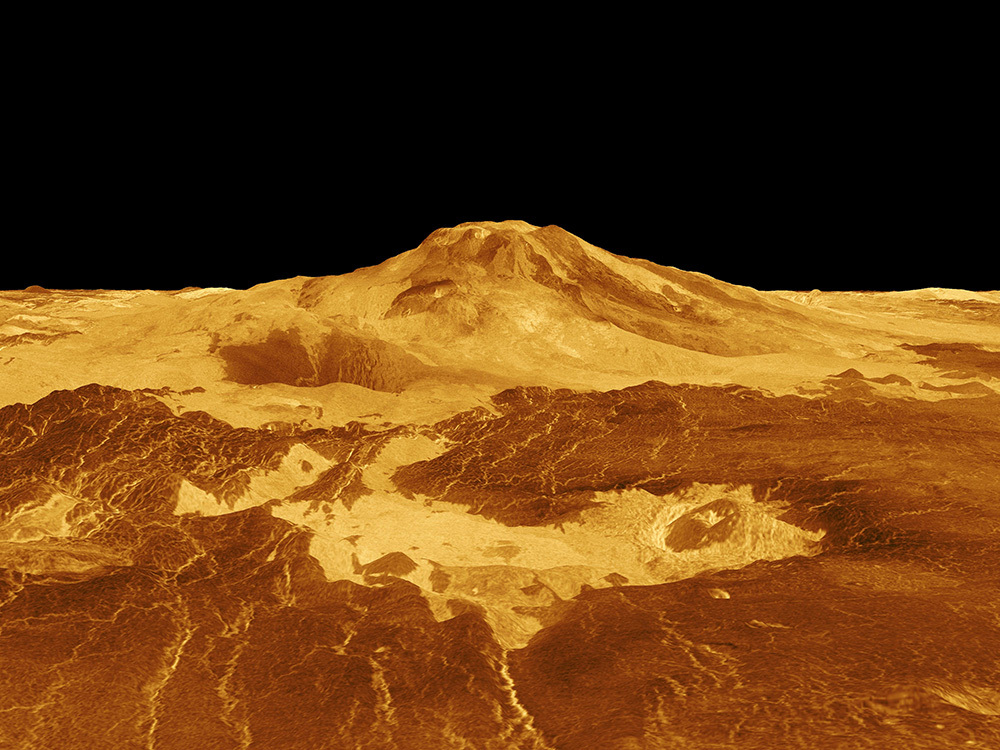4.12.2024
While some have proposed that Venus once hosted oceans on its surface, new evidence suggests that the planet’s interior has been dry for most of its history.

This computer-generated 3D model of Venus's surface shows the summit of Maat Mons, one of the places on the planet that might exhibit current volcanic activity. Volcanism and the gases it emits provides one of the pieces of the puzzle that is Venus's ancient history.
NASA / JPL-Caltech
Three astronomers have poured cold water on the idea that Venus once hosted oceans on its surface, suggesting instead that the planet's interior has been dry for most of its history.
Venus, our nearest planet, is sometimes labeled Earth’s twin, but size is the only real modern similarity. Today, Venus is a hellscape of a world, with oven-like temperatures that soar beyond 460°C. Its thick carbon dioxide clouds, laced with sulfuric acid, crush down on the Venusian surface with such force that the atmospheric pressure is 92 times that of our own planet. Standing on the surface is the equivalent of being 900 meters (3,000 feet) underwater here on Earth.
Astronomers have conducted a long and fierce debate about whether Venus was always so inhospitable. Now, it is the turn of three researchers from the University of Cambridge in the UK to put forward their case. Their findings are published in Nature Astronomy.
The team, led by PhD student Tereza Constantinou, used the present Venusian atmosphere to probe the planet’s past. Venus’s current atmosphere is largely the result of its volcanic history and the gases that activity released. These gases in turn reflect the composition of the planet’s interior.
There are two rival theories of Venus’s past. The first argues that Venus once had widespread oceans — enough water to cover the whole planet to a depth of 500 meters. Then came the volcanoes, which released vast quantities of the greenhouse gases carbon dioxide and sulfur dioxide into the atmosphere. The temperature sky-rocketed and the water evaporated, then escaped into space. Alternatively, Venus has always been too hot to support liquid water and any water vapor originally in the atmosphere likewise escaped.
“Both of those theories are based on climate models, but we wanted to take a different approach based on observations of Venus’s current atmospheric chemistry,” says Constantinou.
Her team calculated the present destruction rate of water, carbon dioxide, and carbonyl sulfide molecules in the planet’s atmosphere. They also examined chemical reactions between Venusian air and surface, by which means chemicals are stored in the planet’s crust. “To keep the Venusian atmosphere stable, any chemicals being removed from the atmosphere should also be getting restored to it, since the planet’s interior and exterior are in constant chemical communication with one another.”
This delicate atmospheric ledger offers a unique way to probe Venus’s volcanic gas emissions and in turn its interior. Constantinou's team concluded that Venus's volcanic gases are at most 6% water. That implies the planet’s interior is too dry to ever have brought large quantities of water to the surface. “Given it likely never had oceans, it is hard to imagine Venus ever having supported Earth-like life, which requires liquid water,” Constantinou says.

Davide Sulcanese / IRSPS - Università d'Annunzio
“This is an intriguing study,” says James Holmes (Open University, UK), who was not involved in the research. “There still remain uncertainties that are likely to influence the results, such as the precise chemical composition of the deep atmosphere and the current rate of active volcanism,” he adds. That data could come from a slew of future Venus missions, including NASA's VERITAS and DAVINCI, and the European Space Agency's EnVISION.
However, not everyone is convinced by these new calculations. “They make two assumptions that I would question,” says Richard Ghail (Royal Holloway, University of London), who was also not involved in the research. “Their assumption about Venus surface weathering is, I suspect, wrong,” he says. If Constantinou's team overestimated the amount of carbonyl sulfide and carbon dioxide that chemical reactions deposit into the planet’s crust, then there would be less of those molecules relative to water. Then, to keep the atmosphere in balance, the amount of water ejected from the planet's interior would need to be higher than Constantinou’s team estimated.
“I think they [also] significantly underestimate the importance of the sulfur cycle,” Ghail adds. The sulfur cycle is one mechanism for putting carbonyl sulfide back in the air, as sulfur-rich minerals break down on the surface, providing another way to shift the ratio of that molecule relative to water. Constantinou’s team admits that the story for sulfur is nuanced and could leave wiggle room for their calculations.
Perhaps it will take those future missions to settle the debate once and for all. After all, it isn’t just Venus we're talking about. “Venus is important for exoplanet science,” Constantinou says, “because it gives us a unique opportunity to explore a planet that evolved very differently to ours, right at the edge of the habitable zone.”
Quelle: Sky&Telescope
